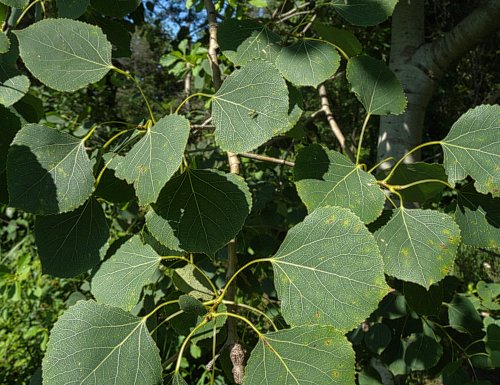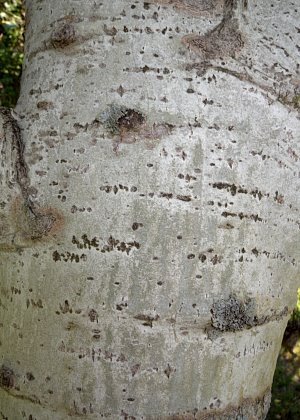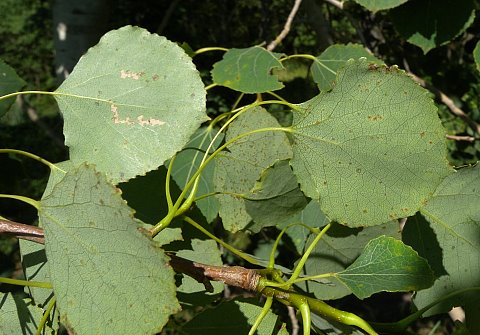
Quaking Aspen is usually dioecious, producing either all male (staminate) catkins or all female (pistillate) catkins on separate trees. However, a small minority of trees produce catkins with perfect florets. These catkins are about 1½-2½" long and drooping. Each floret of a male catkin consists of 5-10 stamens with glabrous filaments that develop from a shallow cup-shaped disk. The upper rim of the disk is oblique. There is also a brown floral bract that is narrowly lobed and hairy along its upper side. Each floret of a female catkin consists of a naked pistil that develops from a shallow cup-shaped disk. The upper rim of the disk is oblique. The pistil is 3-6 mm. long and lanceoloid with bifurcated stigmata at its apex. There is also a brown floral bract that is narrowly lobed and hairy along its upper side. The blooming period occurs during mid-spring for about 1-2 weeks before the vernal leaves unfold. The florets of the catkins are cross-pollinated by the wind. During the early summer, the female catkins become up to 4" long and their seed capsules split open, to release their seeds. Each capsule contains 4-10 tiny seeds that are embedded in cottony hairs. The seeds are distributed by the wind or water. The root system is relatively shallow and widely spreading. Clonal offsets often develop from the lateral roots. As a result, colonies of clonal trees are commonplace. The deciduous leaves turn golden yellow during the autumn.
 Cultivation:
The preference is full sun, moist to dry-mesic conditions,
and a relatively loose soil containing sandy loam or silty loam.
However, this tree also adapts to soil containing gravel or clay. Hot
dry weather during the summer is stressful to this tree. Growth and
development are fairly rapid during the first 20 years of life, after
which this tree grows more slowly. An individual tree is relatively
short-lived (up to 50 years), however a clonal colony of Quaking Aspen
can persist for hundreds and perhaps thousands of years. The tiny seeds
remain viable for only 1-2 weeks.
Cultivation:
The preference is full sun, moist to dry-mesic conditions,
and a relatively loose soil containing sandy loam or silty loam.
However, this tree also adapts to soil containing gravel or clay. Hot
dry weather during the summer is stressful to this tree. Growth and
development are fairly rapid during the first 20 years of life, after
which this tree grows more slowly. An individual tree is relatively
short-lived (up to 50 years), however a clonal colony of Quaking Aspen
can persist for hundreds and perhaps thousands of years. The tiny seeds
remain viable for only 1-2 weeks.Range & Habitat: Outside of cultivation, the native Quaking Aspen is occasional in northern Illinois, rare in central Illinois, and absent from the southern section of the state (see Distribution Map). This tree has a large range in the boreal region of North America. Habitats include upland woodlands, sandy woodlands, sandy savannas, sandy thickets, woodland edges, edges of marshes, bogs, riverbanks, borders of lakes, and abandoned sandy fields. Quaking Aspen is a pioneer species that prefers disturbed habitats, especially burned-over areas. It is able to resprout from its root system after a fire. Quaking Aspen sometimes becomes the dominant tree in these habitats, although it is eventually replaced by other trees in the absence of a regimen of disturbance. Quaking Aspen is occasionally cultivated as a landscape tree for its attractive bark and foliage.
Faunal Associations: Many insects feed on the leaves, bore through the wood, or suck juices from Quaking Aspen and other Populus spp. This includes Chrysomela crotchi (Aspen Leaf Beetle), Chrysomela scripta (Cottonwood Leaf Beetle), and many other leaf beetles (see Leaf Beetle Table) that feed on the foliage. The larvae of some beetles bore through the wood of either living or dead trees. These species include Oberea delongi (Poplar Twig Borer), Oberea schaumi (Poplar Branch Borer), Saperda calcarata (Poplar Borer), Descarpentriesina cyanipes (Eastern Poplar Buprestid), and Dicerca tenebrica (Flat-Headed Poplar Borer). Other insect feeders include the plant bug Orthotylus candidatus, Aphis maculatae (Spotted Poplar Aphid) and Chaitophorus populicola (Poplar Leaf Aphid), the leafhopper Kybos copula, and the treehopper Palonica tremulata (see the Insect Table for a more complete listing of these species). Caterpillars of such butterflies as Limenitis archippus (Viceroy), Limenitis arthemis arthemis (White Admiral), Nymphalis antiopa (Mourning Cloak), and Nymphalis vau-album j-album (Compton Tortoiseshell) feed on the leaves of Quaking Aspen and other Populus spp., as do caterpillars of the skipper Erynnis icelus (Dreamy Duskywing). In addition to these species, the caterpillars of a large number of moths feed on the leaves and other parts of these trees (see Moth Table), including Lobophora nivigerata (Powdered Bigwig), Protitame virginalis (Virgin Moth), Pseudosciaphila duplex (Spotted Aspen Leafroller), and Phyllonorycter apparella (Aspen Blotch Leafminer).

Many vertebrate animals use Quaking Aspen and other Populus spp. as a source of food, protective cover, and nesting habitat. The Ruffed Grouse, Greater Prairie Chicken, and Purple Finch feed on either the buds or catkins, as does the Red Squirrel. The Yellow-Bellied Sapsucker drills holes into the thin bark to access the sap. White-Tailed Deer, Elk, and the Cottontail Rabbit browse on the twigs and foliage of young trees. Such domesticated animals as cattle, sheep, and goats also browse on the twigs and foliage. When Quaking Aspen grows along bodies of water, its bark, branches, and foliage are eaten by the Beaver and, to a lesser extent, by the Muskrat. The Meadow Vole also feeds on the bark below the snow line during winter. Insectivorous birds often visit aspen groves to feed on the many insects that these trees attract. Many birds construct nests on the branches or in the cavities of this tree, including the Red-Breasted Nuthatch, Yellow Warbler, Warbling Vireo, and Northern Flicker. Beavers use the branches of Quaking Aspen in the construction of their dams and lodges.

Photographic Location: Along the sandy bank of a pond underneath a powerline clearance at the Indiana Dunes National Lakeshore in NW Indiana.
Comments: Quaking Aspen has attractive foliage, bark, and autumn coloration. The wood is light, soft, and straight-grained. It has been used to make pulp for paper, particle board, strand board, and plywood. Because the wood doesn't splinter readily, it has also been used to make toothpicks, sauna benches, and wooden structures for playgrounds. Quaking Aspen can be distinguished from similar Populus spp. by the shape of its leaves, the abundance of small teeth along its leaf margins (18-40 per side), its flattened petioles, and light-colored bark. It is similar to Populus tremula (European Aspen), but the leaves of the latter have fewer and larger teeth along their margins. Occasionally, Quaking Aspen forms naturally occurring hybrids with other Populus spp., although such hybrids are relatively rare in Illinois.